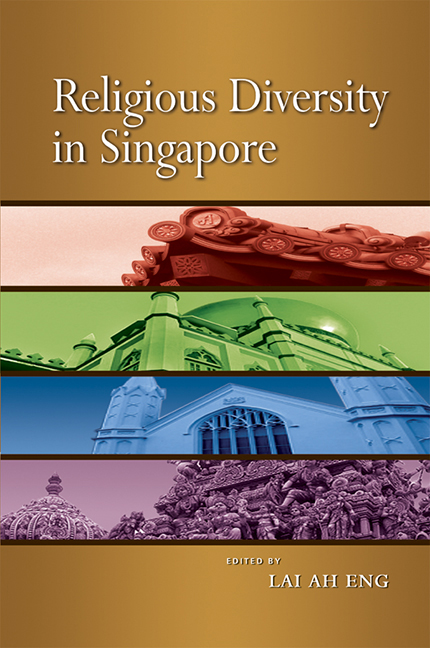Book contents
- Frontmatter
- Contents
- List of Figures and Tables
- List of Appendices
- FOREWORD
- PREFACE
- Acknowledgements
- The Contributors
- Abbreviations
- Glossary
- INTRODUCTION
- PART I The Landscape of Religious Diversity
- 1 Religious Influences and Impulses Impacting Singapore
- 2 Religious Trends and Issues in Singapore
- 3 Keeping God in Place: The Management of Religion in Singapore
- 4 Discourses on Islam in Southeast Asia and Their Impact on the Singapore Muslim Public
- 5 Global Christian Culture and the Antioch of Asia
- 6 “Religiously-inspired”, “India-derived” Movements in Singapore
- 7 Baha'is in Singapore: Patterns of Conversion
- 8 Diversities and Unities: Towards a Reformist Buddhism in Singapore
- 9 The Sathya Sai Baba Movement in Singapore: Its Service Mission and Philosophy of Communal Identity Construction
- 10 The Muslim Religious Elite of Singapore
- 11 The Evolution of the Sikh Identity in Singapore
- 12 Religious Processions: Urban Politics and Poetics
- PART II Religion in Schools and Among the Young
- PART III Religion in the Media
- PART IV Religious Organizations in Social Services
- PART V Interfaith Issues and Interaction
- Index
11 - The Evolution of the Sikh Identity in Singapore
from PART I - The Landscape of Religious Diversity
Published online by Cambridge University Press: 21 October 2015
- Frontmatter
- Contents
- List of Figures and Tables
- List of Appendices
- FOREWORD
- PREFACE
- Acknowledgements
- The Contributors
- Abbreviations
- Glossary
- INTRODUCTION
- PART I The Landscape of Religious Diversity
- 1 Religious Influences and Impulses Impacting Singapore
- 2 Religious Trends and Issues in Singapore
- 3 Keeping God in Place: The Management of Religion in Singapore
- 4 Discourses on Islam in Southeast Asia and Their Impact on the Singapore Muslim Public
- 5 Global Christian Culture and the Antioch of Asia
- 6 “Religiously-inspired”, “India-derived” Movements in Singapore
- 7 Baha'is in Singapore: Patterns of Conversion
- 8 Diversities and Unities: Towards a Reformist Buddhism in Singapore
- 9 The Sathya Sai Baba Movement in Singapore: Its Service Mission and Philosophy of Communal Identity Construction
- 10 The Muslim Religious Elite of Singapore
- 11 The Evolution of the Sikh Identity in Singapore
- 12 Religious Processions: Urban Politics and Poetics
- PART II Religion in Schools and Among the Young
- PART III Religion in the Media
- PART IV Religious Organizations in Social Services
- PART V Interfaith Issues and Interaction
- Index
Summary
INTRODUCTION
Sikhs are a minority ethnic community in Singapore, making up 7,000– 12,000 out of the four million total population of Singapore. They are a visible community in Singapore due to their unique physical appearance and established places of Sikh worship known as gurdwaras. However, like many other Sikh communities within the larger Sikh diaspora, the Sikhs in Singapore are in constant negotiation between their identity as Sikhs and their integration into the social cultural mainstream of Singapore.
The label “Sikh” is a religious one. It denotes a people who originated from Punjab and who adhere to the spiritual teachings of the Sikh gurus. The Sikhs portray a sense of homogeneity as a community because of their unique appearance in which the men wear turbans by requirement and because of the institutionalization of their religious practices. The Sikhs adhere to established standards of an ideal Sikh, which are encoded in rules regarding conduct known as Rehat Meryadas. These codes of conduct are upheld by religious authorities in Amritsar, Punjab, such as the Shiromani Gurdwara Parbhandak Committee (SGPC) that advises and attempts to represent the accepted consensus on Sikh religious practices and the management of Sikh places of worship worldwide. However, in the actual practice of Sikhism, particularly amongst the Sikhs residing outside of Punjab, there is a great divergence from the ideals proselytized by the Sikh religious authorities in the Punjab. This divergence reveals the Sikhs to be far from homogenous and as a community that is fraught with divisions. Although the Sikhs who endeavour to maintain the ideals as promulgated by the seats of religious authority in the Punjab may be in control of gurdwara management committees and main Sikh organizations, they tend to be in the minority in the case of Singapore.
This chapter aims to analyse the gap between the prescribed Sikh identity as advocated by the seats of Sikh religious authorities in the Punjab and disseminated by local Sikh institutions in Singapore and the actual reality in the practice of the Sikh faith.
- Type
- Chapter
- Information
- Religious Diversity in Singapore , pp. 275 - 297Publisher: ISEAS–Yusof Ishak InstitutePrint publication year: 2008



